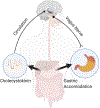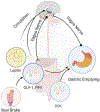Homeostatic regulation of food intake
- PMID: 34481092
- PMCID: PMC9721532
- DOI: 10.1016/j.clinre.2021.101794
Homeostatic regulation of food intake
Abstract
Food intake and energy expenditure are key regulators of body weight. To regulate food intake, the brain must integrate physiological signals and hedonic cues. The brain plays an essential role in modulating the appropriate responses to the continuous update of the body energy-status by the peripheral signals and the neuronal pathways that generate the gut-brain axis. This regulation encompasses various steps involved in food consumption, include satiation, satiety, and hunger. It is important to have a comprehensive understanding of the mechanisms that regulate food consumption as well as to standardize the vocabulary for the steps involved. This review discusses the current knowledge of the regulation and the contribution peripheral and central signals at each step of the cycle to control appetite. We also highlight how food intake has been measured. The increasingly complex understanding of regulation and action mechanisms intervening in the gut-brain axis offers ambitious targets for new strategies to control appetite.
Keywords: Food intake; Hunger; Satiation; Satiety.
Copyright © 2021 Elsevier Masson SAS. All rights reserved.
Conflict of interest statement
Declaration of interests
Figures




References
Publication types
MeSH terms
Grants and funding
LinkOut - more resources
Full Text Sources

